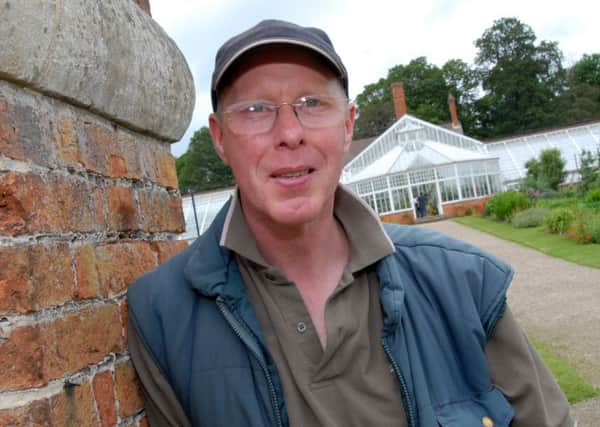Help keep butterflies coming to our gardens


But according to the organisation Butterfly Conservation, three-quarters of UK butterflies are in decline and two thirds of common moth species have seen numbers fall since the 1970s.
This is thought to be due to loss of habitats, climate change and pollution.
Advertisement
Hide AdAdvertisement
Hide AdIn order to help assess the health of our butterflies and moths, and indeed of the environment, we have been taking part in a nationwide survey called the big butterfly count, a project which has support from Sir David Attenborough and Alan Titchmarsh.
We’ve been asking visitors to Clumber Park’s walled kitchen garden to record our butterflies and they’ve been very willing to help.
There are lots of things gardeners can do to encourage butterflies into their gardens.
One of the main ones is to avoid using pesticides, especially those which will remain in the plant for several weeks and could harm the butterflies which feed on the nectar in their flowers.
Advertisement
Hide AdAdvertisement
Hide AdThis will also attract beneficial insects such as bees, ladybirds and hoverflies into the garden.
Damage from insect pests can be controlled or kept in check with organic methods such as biological controls, by growing pest resistant varieties and by using physical barriers, such as netting or fleece, which are far kinder on the environment.
A garden which has a succession of nectar-rich flowers from spring to autumn, growing in sunny, sheltered places will attract the most butterflies.
Summer is easy. Shrubs such as lavender, hebe, caryopteris and, of course, the ‘butterfly bush’, Buddleja davidii, are perfect.
Advertisement
Hide AdAdvertisement
Hide AdMany seed companies also have mixes of butterfly-attracting hardy annuals.
These can be direct sown into prepared soil in spring to provide summer colour and nectar.
Candytuft, cornflower, pot marigold (calendula) and sweet mignonette often feature in these mixes.
For spring, plant wallflowers, Sweet William, elephant’s ears (bergenia) and arabis and for late summer and early autumn, blackberries, ling heather (varieties of Calluna vulgaris) and ice plant (Sedum spectabile).
Advertisement
Hide AdAdvertisement
Hide AdButterflies also need food plants for the caterpillars to feed on.
These are usually wild, native plants, rather than cultivated forms.
Grasses, thistles and stinging nettles can host species such as Red Admiral, Meadow Brown and Painted Lady.
If you grow nettles to make fertiliser, plants should be cut down in mid-summer.
Advertisement
Hide AdAdvertisement
Hide AdThis prevents the flowers producing seed, but gives the first brood of the Small Tortoiseshell enough time to develop.
Last year, more than 52,000 people took part in the big butterfly count, counting more than 580,000 butterflies and moths.
The results of this year’s survey will appear on the big butterfly count website.
We are now into August and it is time to trim beech, yew and Leyland cypress hedges and propagate tender perennials, such as penstemons, fuchsias, pelargoniums and osteospermums, which root readily from non-flowering shoots about five centimetres long.
Advertisement
Hide AdAdvertisement
Hide AdSummer prune wisterias to keep plants well shaped and to encourage flowering spurs to form. Similarly, apples and pears grown as trained forms such as cordons and espaliers should be summer pruned. This also allows air and light into the plants to help ripen fruits and keeps the tree to its trained shape.
Weed, especially with a hoe, working with the weather to hoe off annuals on hot, dry days.
Remove faded blooms from repeat flowering roses and dahlias and annuals such as sweet peas and basket and container plants. This will encourage plants to form more flowers. Keep feeding plants in hanging baskets and containers. A general liquid fertiliser such as tomato feed, which contains high levels of the plant food potassium, is good for flowering plants.
August is the month to sow Japanese onions. These over-winter and should fill the “onion gap”, providing onions next June, after the stored crop has been used, but before the main crop is ready. Spring cabbage can also be sown early in the month, also to over-winter and produce heads or leaves for ”spring greens” in April.
Advertisement
Hide AdAdvertisement
Hide AdVisit gardens with summer bedding displays, herbaceous borders or kitchen gardens, which will all be at their best in August. Gardens opening for the National Gardens Scheme (www.ngs.org.uk) , the Royal Horticultural Society and its partner gardens (www.rhs.org.uk) and the National Trust (www.nationaltrust.org.uk) all have such gardens and many have activities for children during the long summer holiday. In Clumber’s Walled Kitchen Garden there is a garden trail for families called “Where in the World?” which involves finding different vegetables and answering questions about them. For example, which countries do wild potatoes come from and which was the first nation to make chips? The trail runs daily through August and ends on 4 September.